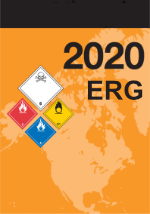UN/NA 3382


 Print
Print
UN/NA 3382 |

|
![]() The ERG recommendations are developed for use during the
initial phase of transportation incidents;
they are not intended for spills at facilities.
The ERG recommendations are developed for use during the
initial phase of transportation incidents;
they are not intended for spills at facilities.
Material Names
|

|
|
| Name of Material | Small Spills (from a small package or small leak) |
Large Spills (from a large package or many small packages) |
||||
|---|---|---|---|---|---|---|
|
First Isolate in all Directions |
Then Protect Downwind |
First Isolate in all Directions |
Then Protect Downwind | |||
| Day | Night | Day | Night | |||
| Poisonous by inhalation liquid, n.o.s. (Inhalation Hazard Zone B) | 100 ft | 0.1 mi | 0.1 mi | 200 ft | 0.3 mi | 0.5 mi |
| Toxic by inhalation liquid, n.o.s. (Inhalation Hazard Zone B) | 100 ft | 0.1 mi | 0.1 mi | 200 ft | 0.3 mi | 0.5 mi |
The ERG doesn't predict that large amounts of toxic-by-inhalation gases will be produced if this material is spilled in water.
| UN/NA | Proper Shipping Name | Hazard Class | Labels | Notes* |
|---|---|---|---|---|
|
* There are three notes: (1) whether the displayed information is for domestic (U.S.) or international shipping (if neither is specifically indicated, it applies to both), (2) whether the proper shipping name must include one or more technical names of the hazardous material in parentheses, and (3) whether the hazardous material is an inhalation hazard. |
||||
| UN | Toxic by inhalation liquid, n.o.s. with an LC50 lower than or equal to 1000 ml/m3 and saturated vapor concentration greater than or equal to 10 LC50 | 6.1 | 6.1 | Technical Name Required, Inhalation Hazard Zone B |
 6.1 - Poison Inhalation Hazard
6.1 - Poison Inhalation Hazard